
Christopher Hocker and Lindsay Martin
On June 29, 2007 – On budget and ahead of schedule – the Long Island Power Authority (LIPA) “flipped the switch” on the Neptune Project, a $600 million project to connect Long Island to the PJM Interconnection grid via a 65-mile undersea and underground cable. Thus began the island’s access to as much as 660 MW of efficient, reliable, and affordable power to power as many as 660,000 homes.
On October 11, 2007, LIPA, along with project developer Neptune Regional Transmission System, LLC (Neptune RTS), and its EPC consortium members – Siemens Power Transmission & Distribution, Inc. and Prysmian Cables and Systems, USA, LLC – dedicated the system with a group of more than 375 that included employees, FERC commissioners, state and local officials, contractors, media and colleagues from utilities across North America. At the ceremony, LIPA announced that the Neptune Project had saved the utility over $20 million in its first 100 days of operation. Neptune is expected to save LIPA more than $1 billion over the next 20 years.
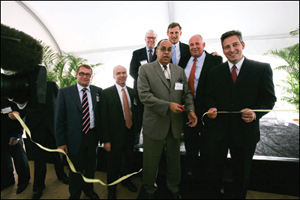
The Need for Neptune
As implied by its name, Long Island is literally that– and with the attractions of an island come some drawbacks, in this case a lack of generation resources to supply power to LIPA’s service territory of more than 3 million residents. Couple this need with scarce and expensive real estate, and the energy future looked cloudy for residents of this New York City suburb.
The answer was just a state away – New Jersey, which, along with 12 other states, is part of PJM Interconnection (PJM), a regional transmission organization with access to approximately 150,000 MW of energy supply from a variety of fuel sources that helps customers of its member companies balance supply and demand, efficiency and price.
Connecting Long Island to PJM via traditional overhead or underground alternating current (AC) transmission lines was cost-prohibitive, so LIPA looked for an alternative, and Neptune presented a solution: instead of an overhead AC cable or more on-island generation, install an undersea transmission line, avoiding expensive right-of-way siting issues with a cable safely buried under the Atlantic Ocean.
Project Overview
The Neptune Project is the largest underwater HVDC project in the U.S. and uses the first 500 kV submarine cable ever installed worldwide. The project consists primarily of cables and controls – a 500 kV, 660 MW high voltage direct current (HVDC) cable connecting a FirstEnergy substation in Sayreville, New Jersey, to LIPA’s Newbridge Road substation in Levittown, New York. Control systems are housed in the Sayreville (New Jersey) and Duffy Avenue (Hicksville, New York) converter stations. The controls are bidirectional, so power can flow in both directions. The entire system can be operated at either substation.
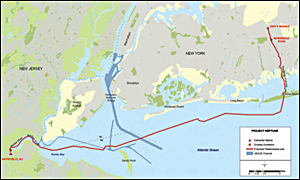
Neptune Project route map
In typical operation, alternating current is drawn from PJM Interconnection and converted to direct current (DC) at the Sayreville converter station for its 65-mile journey under water and underground to the Duffy Avenue substation. At Duffy, it is converted back to AC, then transferred on to the Newbridge Road substation for distribution to LIPA’s service territory, which includes Suffolk and Nassau counties, as well as Rockaway Peninsula in Queens.
HVDC Fundamentals
HVDC (high voltage direct current) transmission systems connect two separate high voltage AC systems via a DC link. The basic principle of operation of an HVDC system is based on the conversion of AC to DC and vice-versa by means of converter valves comprising power thyristors, which are the heart of a converter station.
Thyristors are used as switches and thus the valve becomes controllable. The thyristors are made of highly pure monocrystalline silicon. The high speed innovation in power electronics technology is directly reflected in the development of the thyristor. Siemens used state-of-the-art light-triggered thyristor in the Neptune Project – by injecting photons into the gate instead of electrons, the number of components inside the thyristor valve is reduced by up to 80%. This simplification results in increased reliability and availability of the transmission system.
Direct light-triggered thyristors with integrated over-voltage protection is now a proven technology and the Siemens standard. It was implemented successfully for the first time in 1997 at the Celilo Converter Station of the Pacific Intertie in California.
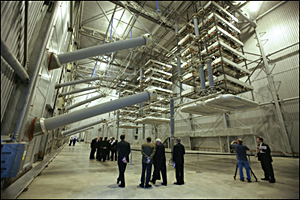
Valve hall, Duffy Avenue Converter Station
Due to the highly populated areas in which both converter stations are located, special measures for reducing certain impacts were implemented. For example, in addition to AC passive filters, active filters were installed to eliminate harmonic currents, which are produced with the operation of the HVDC within an AC grid and might cause issues with area telephone networks.
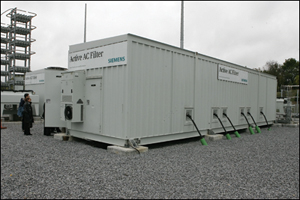
Active AC Filter, Duffy Avenue Converter Station AC Switchyard
The project required four transformers at each location, three in service and one spare.
One of the key goals of the project was minimal disruption to the local communities, including impacts associated with the transportation of transformers that each weighed hundreds of tons.
Waterways were used as much as possible to minimize shutting down major surface corridors in both New Jersey and New York.
In Sayreville, the barge carrying the transformers was able to dock conveniently within yards of the converter station. Then each transformer was unloaded and transferred to special multi-wheeled trailers using a 750-ton Weeks Marine barge-mounted crane. The trailers were designed to spread the load evenly so as not to damage roadways or disrupt underground services.
At the Duffy Avenue site the same method was used, off-loading the transformers at a nearby port and moving them along surface roadways at night to avoid local traffic disruptions.
After arriving at their destinations, riggers then slid each of the transformers in place with high-powered hydraulic ratcheting slides.
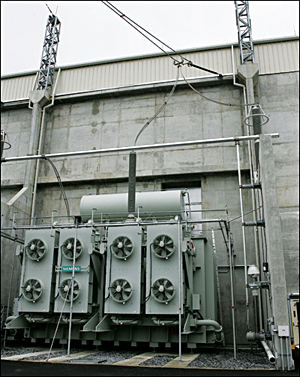
One of four transformers at the Duffy Avenue Converter Station
As leader of the EPC consortium, Siemens provided valuable technical assistance for Neptune in obtaining required approvals and permits from state and local agencies related to the converter stations. Permitting the Neptune project was a particular challenge in that it required a wide variety of approvals in both New York and New Jersey, as well as a permit from the U.S. Army Corps of Engineers for submarine cable installation.
Construction of the two converter stations commenced simultaneously in October 2005. Since the two substations are in different states, many aspects of the project required efforts on multiple fronts in dealing with various state and local requirements, as well as the management of two separate labor agreements.
One of the unique aspects of the project was that both converter station sites involved “re-purposing” land that had previously been virtually abandoned and unproductive. A portion of the Duffy Converter Station site on Long Island was formerly a closed landfill containing road debris. The landfill was uncovered, regraded, and re-sealed in accordance with environmental agency requirements and now is an integral part of the facility.
In Sayreville, the converter station stands on the site of the former Sayre & Fisher brick factory that had been active from the latter half of the 19th century well into the 20th, and had once been one of the largest such operations in the U.S. However, the factory facilities had been largely removed and the site had been abandoned and left derelict. The municipality worked closely with Neptune to formulate plans for transforming the site in a way that was compatible with the primarily residential surrounding neighborhood.
At both sites, underlying foundation conditions were stabilized by driving steel piles into the soil and filling them with concrete.
Repurposing the land in these ways recycled otherwise unusable space in urban and suburban environments, demonstrating that a highly complex project such as Neptune can co-exist successfully with heavily populated areas.
While Siemens was advancing construction of the converter stations, its consortium partner, Prysmian Cables and Systems of Milan, Italy, was proceeding on the installation of the power cable both underground and underneath the water.
The Neptune cable was produced in the Prysmian manufacturing facility in Arco Felice (Naples). Designed to carry a rated power of 660 megawatts and not less than 750 MW in exceptional overload, the cable covers a distance of 65 miles. The largest portion of the route – more than 50 miles – runs underwater, starting in the Raritan River in Sayreville and proceeding into Raritan Bay and the Atlantic Ocean to a point near Jones Beach on Long Island. The underground portion of the cable runs approximately 14 miles in conduit along the existing right-of-way in the eastern shoulder of the Wantagh State Parkway.
The submarine portion of the transmission line consists of three cables – a 500 kV HVDC cable, a fiber optic cable and a medium voltage metallic return cable. They are installed in bundle configuration, fastened together with ropes and straps applied before approaching the laying sheave.
The cable was installed in two “campaigns,” or phases. The first campaign started in the ocean at the approximate midpoint of the route and proceeded toward the Raritan River. An installation barge drawn by tugboats was used to pull the Hydroplow in order to navigate in the relatively shallow waters of the river. For the second campaign, Prysmian used its specially-equipped cable laying ship Giulio Verne which could proceed more quickly in the deeper waters of the open ocean from the midpoint to Long Island.
Under water, Prysmian used its own jet plow technology, called the “Hydroplow,” to install the cable. The Prysmian vessel towed the Hydroplow along the river or sea bottom, while spooling the DC cable from the rear of the vessel through the Hydroplow. The Hydroplow was equipped with a “stinger,” or blade, that created a trench, as well as water jets to fluidize the sediments in the trench as the cable was laid. The sediments then resettled in the trench. This installation method was approved by environmental agencies as having minimal impact on the underwater environment. For most of the underwater route, the cable was buried approximately six feet below the sea bottom or river bed.
At each end of the submarine route, Prysmian prepared landfall areas by drilling between land and designated underwater locations. The ends of the cable were floated out to the landfall points and divers fed the cable into the landfall openings to complete the connection.

Cable System Technology
Why Long Distance / Sea Cable HVDC?
• No reactive power loading of the transmission line
• Complete control of energy flow
• No contribution to short circuit power in existing AC networks
• Reduced losses
Project Timeline
September 2001 – environmental studies and siting began
June 2004 – Neptune Project selected by LIPA to meet future energy demand on Long Island
June 2005 – Siemens and Prysmian selected to provide manufacturing and installation of the cable, converter stations, and station components
October 2005 – construction began simultaneously at the two converter stations
2006-07 – cables were laid undersea and underground
Spring 2007 – system testing conducted
June 28, 2007 – Neptune Project started commercial operation
October 11, 2007 – Neptune Project dedication ceremony
Value of HVDC in Urban and High Growth Areas
In urban and high growth areas, HVDC is a viable alternative to traditional AC systems because high volumes of electricity can be transferred long distances without high charging current and with reduced line losses.
HVDC technology has already been used numerous times for undersea transmission via submarine cables. The parallel operation of HVDC systems and HVAC connections has proven cost-effective in a number of cases. HVDC back-to-back converters allow coupling of grids, elimination of loop flows and controlling of power flow.
About the Authors
Lindsay Martin is currently a Director of Business Development with Siemens Power Transmission & Distribution, Inc., based in Wendell, NC. He has spent the past 5 years working in FACTS & HVDC Busness Development. Previously, Mr. Martin managed a Siemens Engineering Consulting and Project business.
Chris Hocker joined Neptune RTS as Vice President of Planning after 20 years of experience in the electric power industry that encompasses project planning, licensing and permitting, government and community relations, business development, and corporate communications. Between 1990 and 2004, he was employed by Enel North America, Inc. He later served as Senior Vice President, Corporate Affairs, for CHI and Enel North America, part of the senior management team responsible for corporate development. He served on the board of directors of the National Hydropower Association. Mr. Hocker holds a BA degree from Stanford University.







